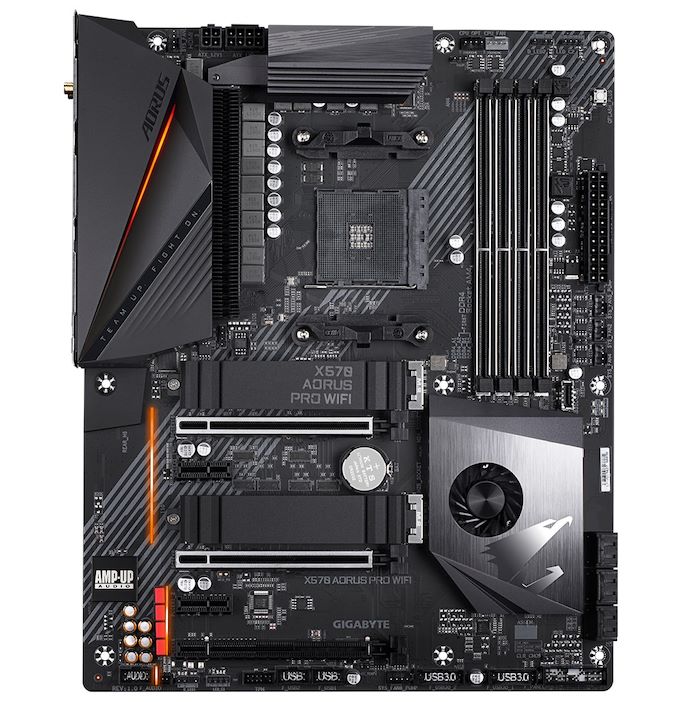The AMD X570 Motherboard Overview: Over 35+ Motherboards Analyzed
by Gavin Bonshor on July 9, 2019 8:00 AM ESTGIGABYTE X570 Aorus Pro & X570 Aorus Pro WIFI
The GIGABYTE X570 Aorus Pro is offered in two versions, with and without Wi-Fi and represents its mid-range product stack with a Realtek ALC1220-VB audio codec, Intel Gigabit LAN, and an HDMI 2.0 output on the rear panel. Both models share the same PCB, aesthetics and overall circuitry, with the only difference coming in the wireless connectivity; users can sacrifice Intel AX200 Wi-Fi 6 and BT 5.0 wireless interface for a small price reduction. The positioning in GIGABYTE's X570 product stack slots it between the more premium X570 Aorus Ultra ($299), and the more cost-effective X570 Aorus Elite ($199 to $209).
The GIGABYTE X570 Aorus Pro uses a strong looking 14-phase power delivery which is suitable for enthusiasts looking to squeeze out some extra performance from the new Ryzen 3000 series processors; it should be noted that GIGABYTE is using the same power delivery as the more expensive X570 Aorus Ultra ($299). A total of four RAM slots with support for DDR4-4400 and up to 128 GB sit towards the right-hand side, while the bottom area is dominated by three full-length PCIe 4.0 slots which operate at x16, x8/x8, and x8/x8/x4. For storage, there are two M.2 slots each with their own individual heat shields as well as six available SATA ports.
On the rear panel is a single Intel I211-AT Gigabit Ethernet port with a Realtek ALC1220-VB HD audio codec driving the five 3.5 mm audio jacks and the S/DPIF optical output. In terms of rear panel USB, there is single USB 3.1 G2 Type-C, two USB 3.1 G2 Type-A, three USB 3.1 G1 Type-A, and four USB 2.0 ports. A single HDMI 2.0 video output is also present for users looking to utilize one of AMD's Ryzen based APUs, with the X570 Aorus Pro WIFI variant adding antenna connectors for the Intel AX200 Wi-Fi 6 802.11ax wireless interface; this also has support for BT 5.0 devices.
The GIGABYTE X570 Aorus Pro WIFI has an MSRP of $269 which offers users with a solid feature set, and all-in-all is a slightly cut-down version of the more expensive X570 Aorus Ultra ($299). For the $30 drop in the cost of the GIGABYTE X570 Aorus Ultra, the X570 Aorus Pro WIFI drops one of the PCIe 4.0 x4 M.2 slots, but for users looking for a model without the Intel AX200 Wi-Fi 6 wireless interface, the non Wi-Fi enabled X570 Aorus Pro looks set to come in with an MSRP of $259.












225 Comments
View All Comments
abufrejoval - Tuesday, July 9, 2019 - link
It's amazing how quickly you run out of PCIe lanes, when you don't have switches to multiplex and translate between PCIe revisions and lanes (e.g. PCIe v4 x2 <-> PCIe v2 x8).I find myself using USB 3.x NBase-T NICs and NVMe adapters, simply because they *do* switch.
Bensam123 - Tuesday, July 9, 2019 - link
Maybe a bit more depth on the power delivery page. I have absolutely no idea how to go about parsing what's there. More chokes is better? What denotes a power phase?A5 - Tuesday, July 9, 2019 - link
+1. Some analysis of that information would be helpful.MrSpadge - Tuesday, July 9, 2019 - link
+1bunkle - Wednesday, July 10, 2019 - link
The controller column includes the total number of phases supported split between CPU cores and SoC e.g. (6+1) = 6 CPU phase and 1 SoC phase. More is *usually* better but has diminishing returns regarding tighter and tighter voltage regulation. Some controllers are better than others (can operate at high frequency e.g. 500KHz v 1000KHz, include other features to improve performance) mitigating the need for more phases.Each phase is a buck converter comprised of a low/high side MOSFET (can be integrated in a single package) and choke. Some controllers can support doubling up the PWM signal to driver more MOSFETs. Doublers can also be added as discrete components if not built into the controller.
Current rating of the MOSFET (e.g. Sic639=40A IR3555=60A) indicates the total power deliverable. MOSFETs are not 100% efficient and vary in efficiency. The more current they provide the hotter they get and the less efficient they become, with better MOSFETs producing less heat for a given current. Thus using doubles can improve temperatures and efficiency without the benefits of the tighter voltage tolerance that *real* phases provide.
Hope that’s helpful!
bunkle - Wednesday, July 10, 2019 - link
A lot more detailed explanation: https://en.wikichip.org/wiki/voltage_regulator_mod...bug77 - Tuesday, July 9, 2019 - link
The description for AsRock X570(M) Pro4 says "5 jack + 1 SPDIF". Unfortunately, those boards lack SPDIF and only come with 3 jacks ;)Smell This - Tuesday, July 9, 2019 - link
I'm thinking the *ASRock Thunderbolt AIC* ...https://thunderbolttechnology.net/product/asrock-t...
would cover all your TBT peripheral needs, including optical.
DanNeely - Tuesday, July 9, 2019 - link
Do X570 boards still need an extra chip per USB port to support USB-C reversibility?The additional expense and needed PCB space were cited as among the reasons why earlier generation boards (IIRC both Intel and AMD) almost never had more than 1 C port; but it was never clear to me if that was an inherent implementation penalty for the C port or an artifact of Intel's tech stack being stalled out and AMD outsourcing to ASMedia which built the chipsets on an ancient (55nm) platform.
DigitalFreak - Tuesday, July 9, 2019 - link
Gavin - X370 and X470 only supported PCIe 2.0. The connection between the CPU and chipset was 3.0, but all the ports on the chipset were 2.0.